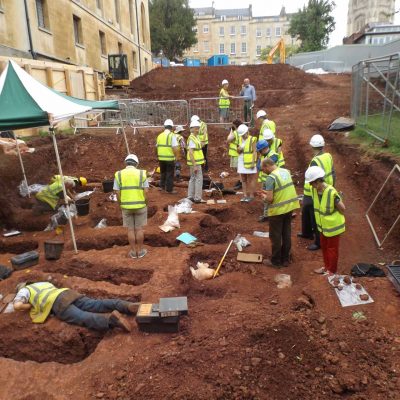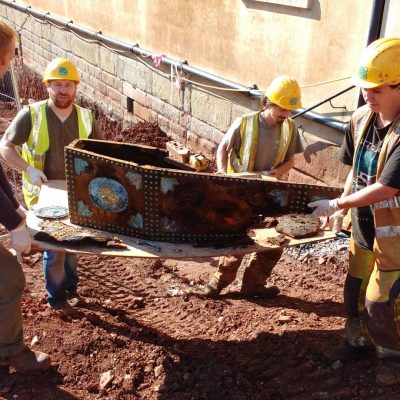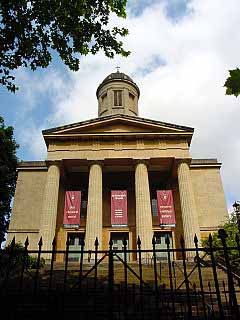

St. George’s Brandon Hill have put a massive extension on the west side of the building, which has proved to be controversial. Avon Archaeology undertook excavation in the old graveyard area and discovered 400 burials. The remains of a cat was found lying on top of one of the lead coffins. Inside the coffin was a 17 year old individual with an infant inside. The old graveyard was in the area that was revetted into three terraces.
The church appears in the 1750 map by John Rocques. By 1828 there are three terraces and it is called St. Augustine’s Chapel. This acted as an overflow graveyard for St. Augustine the Less, but later it was decided to have a Chapel of Ease.
Building the church: Robert Smirke was the architect of the church that was built c. 1920-21. He noted there was a quarry and he noted the costs in detail which has proved to be a valuable source of information. The excavation by Avon Archaeology Ltd. took four months and afterwards the documentary searches were carried out. In 1832, St George’s was provided with its own parish, but the boundary between St Augustine’s and the new St George’s parish, was drawn right down the eastern side of the church, so that all of the excavated burials were in fact not in St George’s parish, but in St Augustine’s. Of the 600 burials, when they were actually buried, all of the individuals would have had some form of identification on their coffins, mainly metal name plates, but we could only identify about 66 of them because all the other name plates that had once existed, had disintegrated.
Excavation: this began in the middle terrace, Area 2. Ledger slabs had been laid in situ, exactly where the archaeologists found them and they were then moved with a machine and found they were inscribed. Below them were burial vaults built of brick and covered with rough slabs. Rich people were buried here. It was found that the graveyard was socially stratified. Some of the vaults had coffins inside; there was a painted coffin and one covered in leather and studs.
Area 3 was the lowest terrace and should not have been excavated as it was problematic. This was the area where the less privileged were buried. Some graves were stacked one on top of the other and one had eleven stacks of coffins.
Area 1 only had 1-2 people buried in a cut.
Copper alloy plaques were found on top of some of the coffins. Some crumbled upon excavation, but others survived and it was possible to identify individuals. For example, Anne Vaughan died on 31 May 1885, aged 77. Her coffin plate had a shield.
In 1863/4 St. George’s closed by law, but in the graveyard were some family vaults and they were allowed to add later bodies. One lead coffin of May Stewart had skin preserved inside. This caused a Health & Safety issue for he excavators
To record such a quantity of features during excavation, rectified photography was used through a planning frame, which was much quicker than drawing by hand.
Small finds: these include copper alloy buttons. There was a bone comb, dentures of gold teeth; human teeth known as ‘Waterloo teeth’; bone buttons, a brass ring. Of the entire group of finds there were only two rings found. There were also coffin handles.
Post mortem: there had been some intervention on some of the skeletons, for example the top of a skull had been sawn off. Others examples of this had been neatly done, but others not so. Was this to find the cause of death or to be used in teaching? Examples were found from all the terraces. There were broken and healed bones on S1310; S164 had an elbow amputated; S166 an adult male had a left femur amputated and survived. He was given a peg leg with a buckle and strap. The documentary evidence supports some of this evidence.
One of the burials was for George Cumberland, who was an artist of the Bristol School. He died aged 96 years and is the person who drew the detailed scale hillfort plan of Worlebury. His ‘wife’ Eliazabeth died aged 85 years and they are buried together outside a vault.
St. George’s Brandon Hill was one of the largest groups of burials of this date outside of London to be excavated from a historic graveyard under fully controlled archaeological conditions and a bone specialist is currently undertaking work on the skeletons. The post-excavation work is continuing.


Excavations at St. George’s graveyard. Removing one of the coffins.
Images Avon Archaeology Ltd.

St. George’s today.
